Vintage and Antique Jewelry Periods
Interested in the history of Vintage and Antique Jewelry Periods? Read on to learn more about the years and periods from 1836 through 1950. Each jewelry period tells a bewitching story!
Victorian Jewelry Period (1836 – 1901)
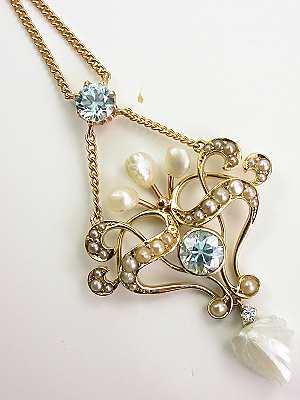
Victorian Jewelry Period (1836 – 1901)
The Victorian era, named for Queen Victoria’s reign in Great Britain, is a fascinating period that spanned over six decades. Its jewelry is often divided into three sub-periods, each reflecting a different phase in the Queen’s life:
- Early Victorian (Romantic Period, 1837-1860): This time was marked by Queen Victoria’s marriage to Prince Albert and the beginning of their family. Jewelry reflected this romantic sentiment with motifs like flowers, hearts, birds, and snakes (a symbol of eternal love, inspired by the Queen’s engagement ring). Materials included colorful gemstones such as garnets, amethysts, turquoise, and coral, often set in yellow or rose gold. The use of seed pearls was also common.
- Mid-Victorian (Grand Period, 1860-1880): This era was defined by Queen Victoria’s mourning for Prince Albert, who passed away in 1861. The jewelry shifted to a more somber and serious tone. Mourning jewelry became highly popular, incorporating black materials like jet, onyx, and black enamel. Sentimental pieces featuring human hair woven into intricate designs were also common. The discovery of diamonds in South Africa in the late 1860s made them more accessible, and they began to appear more frequently in jewelry.
- Late Victorian (Aesthetic Period, 1880-1901): As the Queen came out of deep mourning, the jewelry became lighter and more feminine. This period was influenced by a renewed interest in art and aesthetics. Motifs included stars, crescent moons, and insects. Diamonds, particularly in the “Old Mine Cut,” became very popular. Platinum was introduced as a new metal, though silver and gold remained dominant.
Learn more about the Victorian jewelry period and decide if a Victorian ring is perfect for you.
Art Nouveau Jewelry Period (1890 – 1919)
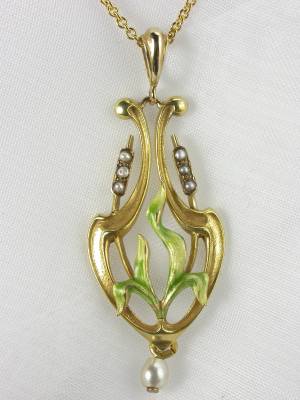
Art Nouveau Jewelry Period (1890 – 1919)
Art Nouveau, meaning “New Art,” was a short but incredibly influential period that completely broke from the historical revivals of the Victorian era.
- Key Characteristics: This movement was a direct reaction to the industrial age, celebrating craftsmanship and the organic beauty of nature. The designs are characterized by long, flowing, asymmetrical lines. The female form with long, flowing hair was a dominant motif, often intertwined with natural elements.
- Motifs: Nature was the primary source of inspiration. Butterflies, dragonflies, snakes, and a variety of flowers like lilies, orchids, and poppies were prevalent.
- Materials: The focus was on design and artistry, not the intrinsic value of the materials. Jewelers used a diverse range of stones and unconventional materials. Cabochon-cut gemstones (domed and polished, not faceted) like moonstones, opals, citrines, and peridots were popular. Other materials included horn, carved glass, enamel (particularly plique-à-jour, which resembles stained glass), and ivory.
- Famous Jewelers: The most renowned jeweler of this period was René Lalique, whose work is a prime example of the Art Nouveau style. He treated gemstones as accents to his intricate designs, often focusing on enamel and carved glass.
Learn more about the Art Nouveau jewelry, which embraced nature and art above all else. You just might fall in love with an Art Nouveau ring!
Edwardian Jewelry Period (1901 – 1920)
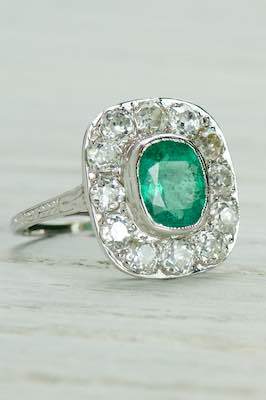
Named after King Edward VII, this period overlapped with the end of Art Nouveau and was heavily influenced by the glamour and opulence of the royal court.
- Key Characteristics: Edwardian jewelry is known for its light, delicate, and lacy appearance. This was made possible by the introduction of platinum, a strong and durable metal that allowed jewelers to create intricate filigree work that resembled lace. The style is also known as the “Belle Époque” in France, meaning “Beautiful Era.”
- Motifs: Bows, garlands, wreaths, and ribbons were popular motifs, often centered around a diamond or pearl.
- Gemstones and Metals: Diamonds were the undisputed king of gemstones, often cut in the new “Old European Cut” or “Rose Cut.” Pearls were also extremely fashionable. The primary metal was platinum, which provided the perfect setting to showcase the brilliance of diamonds without adding a yellow hue.
- Specific Pieces: The “dog collar” necklace, a wide choker, became a fashion staple thanks to Queen Alexandra. Tiaras, dangling earrings, and delicate brooches were also highly sought after.
Learn more about the Edwardian jewelry era. You’ll be enchanted by this romantic period in history and the intricately designed vintage engagement rings crafted during this time.
Art Deco Jewelry Period (1920 – 1935 )
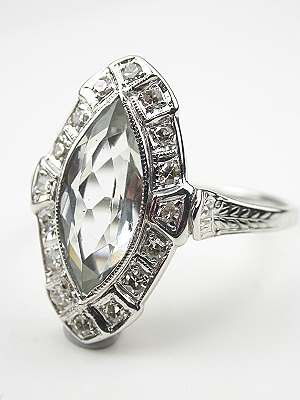
A sharp contrast to the flowing lines of Art Nouveau and the delicate filigree of the Edwardian era, Art Deco jewelry was a celebration of the Jazz Age.
- Key Characteristics: This style embraced modernity, symmetry, and bold, geometric designs. It was influenced by Cubism, machine-age technology, and the discovery of King Tutankhamun’s tomb in 1922, which brought Egyptian and ancient motifs to the forefront.
- Motifs: Designs featured sharp lines, bold curves, chevrons, and stepped patterns. Egyptian motifs like the sphinx and falcon were popular.
- Gemstones and Metals: Color was back in a big way. Jewelers used vibrant combinations of emeralds, sapphires, and rubies, often set alongside diamonds in platinum or white gold. The new geometric cuts for gems, like the baguette and emerald cut, were perfectly suited for the symmetrical designs of the era.
- Famous Jewelers: Cartier, Van Cleef & Arpels, and Tiffany & Co. were prominent designers of this period, creating iconic pieces that are still highly collectible today.
- Specific Pieces: Long, dangling earrings, cocktail rings, and diamond watches were all the rage, complementing the short hairstyles and flapper fashion of the day.
Learn more about the Art Deco jewelry period and the tremendous impact this era had on jewelry, fashion, art, and architecture. Many stunning engagement rings are from this period.
Retro Jewelry Period (c1935 – 1950)
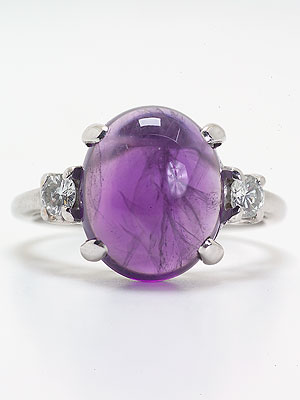
This period, which spanned the Great Depression and World War II, was defined by its practicality and bold, colorful designs.
- Key Characteristics: Retro jewelry is characterized by its chunky, oversized, and often flamboyant style. It used large, rectangular-cut synthetic or semi-precious stones.
- Historical Context & Materials: During World War II, platinum was a strategic metal and its use in jewelry was restricted. This led to a resurgence of yellow, rose, and green gold. Jewelers experimented with multi-colored gold combinations to create striking pieces. Synthetic stones like rubies and sapphires were popular due to wartime material shortages. Other popular gemstones included large, colorful semi-precious stones like citrines and aquamarines.
- Specific Pieces: Charm bracelets came into vogue, worn with a profusion of charms. Large, bold “cocktail” rings and “illusion settings” in engagement rings, which made smaller diamonds look larger, were also favored by the economy-minded consumers of the time. The designs often featured scrolls, ribbons, and bows.
Learn more about the Retro jewelry and how you can make this historical period part of your personal style.
